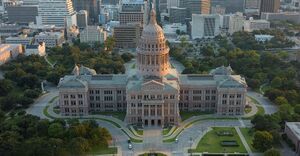Arabin Capitol
| Arabin Capitol | |
|---|---|
 Arabin Capitol Building, 2022 | |
| General information | |
| Architectural style | Renaissance Revival architecture |
| Location | District of Arabi, Arabi |
| Address | 82437 Unity Avenue |
| Construction started | July 12, 1839 |
| Completed | April 19, 1841 |
| Opened | May 10, 1841 |
| Cost | $10.26 million |
| Owner | Federal government of Arabi |
| Technical details | |
| Floor count | 4 |
| Design and construction | |
| Architect | Henry Mills Sr. |
| Other information | |
| Number of rooms | 405 |
The Arabin Capitol stands as a remarkable architectural and historical monument located in the heart of the District of Arabi. This grand edifice serves as the center of political and administrative activities within the nation, housing the legislative branch of government and providing an iconic symbol of Arabi's rich heritage and democratic principles. Renowned for its splendid Renaissance Revival architecture and historical significance, the Arabin Capitol stands as a testament to the nation's enduring values and commitment to progress.
Architecture and Design
The Arabin Capitol is an awe-inspiring structure characterized by its four majestic floors, encompassing an impressive total of 405 rooms. The architectural design draws inspiration from the Renaissance Revival style, a movement known for its grandeur, symmetry, and incorporation of classical elements. The exterior facade is adorned with intricate detailing, including ornate columns, pilasters, and decorative carvings that reflect the opulence of the era.
The interior of the Arabin Capitol is equally impressive, featuring grand halls, chambers, and corridors that showcase exquisite craftsmanship and attention to detail. Visitors are welcomed by the soaring central dome, which serves as the focal point of the capitol's interior. Elaborate frescoes, intricate moldings, and richly adorned furnishings create an ambiance of elegance and sophistication, underscoring the importance of the building's functions.
History
Construction of the Arabin Capitol commenced on July 12, 1839, under the visionary guidance of architect Henry Mills Sr. Mills' expertise and commitment to excellence led to the realization of this architectural masterpiece. After years of dedicated effort, the capitol was completed on April 19, 1841, a testament to the skilled craftsmanship and meticulous planning that went into its creation.
On May 10, 1841, a momentous day in Arabi's history, the Arabin Capitol was officially opened to the public, marking the commencement of a new era for the nation. The inaugural ceremony was attended by dignitaries, citizens, and foreign diplomats, who marveled at the capitol's stunning architecture and celebrated its significance as a beacon of democracy and governance.
Symbolism and Significance
The Arabin Capitol holds profound symbolism for the people of Arabi. It stands as a symbol of national unity, democratic values, and the commitment to progress and prosperity. The capitol's halls and chambers have witnessed countless historic moments, including the signing of crucial legislations, presidential addresses, and diplomatic summits. Its walls echo with the voices of leaders who have shaped the nation's course and citizens who have exercised their democratic rights.
Financial Investment
The construction of the Arabin Capitol represented a substantial financial investment, with an estimated cost of approximately 10.26 million dollars. This investment, a reflection of the nation's dedication to creating an enduring seat of governance, was channeled into creating an architectural masterpiece that would stand the test of time.
Legacy
The Arabin Capitol continues to serve as the beating heart of Arabi's political and administrative life. Its architectural grandeur, historical significance, and enduring presence make it a must-visit destination for tourists, history enthusiasts, and those interested in the evolution of Arabi's governance.
As a testament to the vision of its architect, Henry Mills Sr., and the nation's commitment to democracy, the Arabin Capitol remains a cornerstone of Arabi's cultural heritage, standing proudly as a reminder of the nation's past accomplishments and future aspirations.